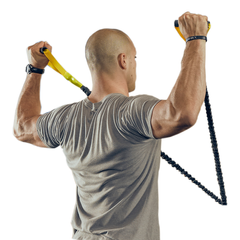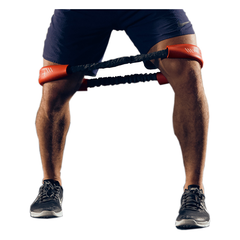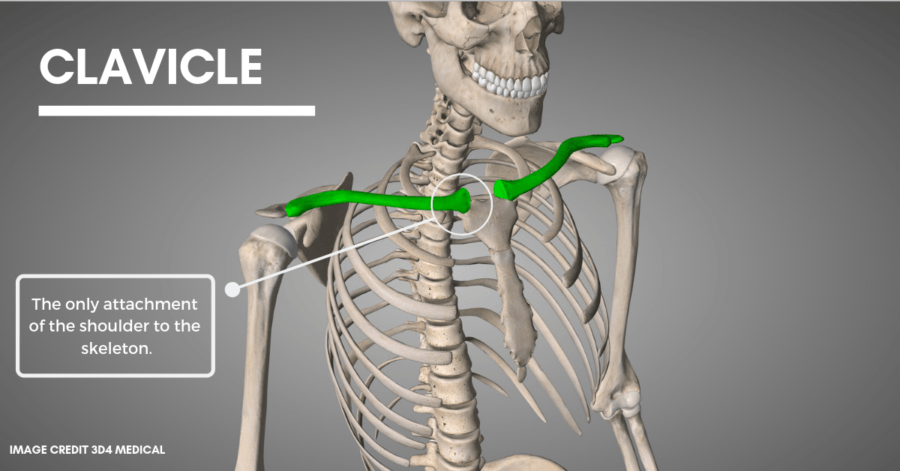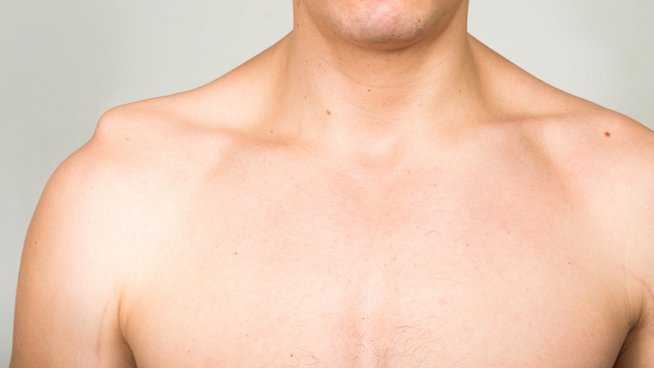Chapter 0:
The Ultimate Guide to Shoulder Pain Rehab

This guide is the perfect resource for anyone who struggles with shoulder pain and wants to learn how to fix it on their own. It's also a necessary tool for the coach or fitness trainer who works with people that deal with shoulder pain.
The Ultimate Guide to Shoulder Pain Rehab creates a better understanding of the causes of shoulder pain and lays out a strategy to get past it.
About the Ultimate Guide to Shoulder Pain Rehab
You don't need an advanced medical degree to understand why your shoulder hurts and what you need to do to fix it. If you struggle with shoulder pain, there is a good chance you can successfully improve how your shoulders feel and move with this plan of attack (even pain that's bothered you for years, and that's without drugs or surgery!)
The Ultimate Guide to Shoulder Pain Rehab is based on medical principles and will apply tactics used by physical therapists everywhere. However, it's essential to understand, every condition is different, and some may need to get more advanced medical help for their shoulder problem (which you will determine with a self-screen as part of this guide.) Regardless, this guide will allow you to become more active in managing your health, which is vital in correcting the issue.
What You Will Learn
The Build- An understanding of the shoulder makeup will help you understand where the trouble lies and what you need to do to fix it. Anatomy and movement can be complicated, but we will break it down into simple pieces and avoid medical terms to keep things clear.
The Breakdown- There are a few key places that shoulder pain often occurs. This will answer the questions of how and why behind shoulder pain.
The Fix: With a better understanding of the shoulder and its pain points, you're now ready to set up a corrective plan to fix it. If you can build a plan and make it happen, you will be on the road to success.
We've organized the plan with this blueprint in mind, and each layer should provide a deeper understanding of the ultimate goal– to end shoulder pain. The guide is set up for easy navigation to jump around, but if you're unsure about your pain issue, we recommend that you go through the chapters in order.
The body can be complex, especially when it comes to pain, so take your time on each step to read and study the material. It may take a few read-throughs for things to set in.
Now... Let's Get Started
Chapter 1:
Intro to Shoulder Pain Rehab

Chapter 2:
Shoulder Pain Assessment

Chapter 3:
Shoulder Impingement

Chapter 4:
Rotator Cuff Tears

Chapter 5:
Shoulder Labrum Tear
A labrum is a structure in the shoulder that's prone to injury.
To understand why, take a second and observe the shoulder. We covered this issue with shoulder anatomy in the Intro to Shoulder Pain Rehab, but we'll reemphasize it here again.
The ball is 3x the size of the socket. It's more like a ball on a tee than an actual "ball and socket."
It's not all that stable, but the shoulder does have excellent mobility.
Now, sandwiched between the arm bone and shoulder socket is the labrum.
Most specifically, it encircles the shoulder socket and performs several important jobs, including:
- Deepen the socket to support stability,
- Provide an attachment to anchor ligaments and tendons,
- Create a negative pressure to further stability—think of it as a suction cup.
In summary, the labrum provides extra stability for a joint needing help.
In this article, we'll explore the labrum further, especially related to pain and injury, and shine some light on how to fix issues related to a torn labrum.
But spoiler alert…the labrum doesn’t fix itself.

Chapter 6:
Shoulder Separation

Chapter 7:
Frozen Shoulder
The most frustrating part of frozen shoulder isn’t just the pain—it’s the timeline that can stretch on for months or even years, with little way of knowing the prognosis.
That uncertainty is where having a plan matters.
An exercise system like Crossover Symmetry can play an important role in recovery, but frozen shoulder is more complex than simply “do these exercises, and you’ll be fine.”
Let’s break down what frozen shoulder actually is, what the research supports, and how to manage it intelligently at each stage.
What is Frozen Shoulder?
Frozen shoulder, also known as adhesive capsulitis, is caused by inflammation and thickening of the connective tissue that surrounds the shoulder joint. The underlying causes remain uncertain and even sometimes appear out of the blue.
That said, frozen shoulder is more common in:
-
People with diabetes
-
Individuals who’ve had prolonged shoulder immobilization (often after injury or surgery)
-
Women, particularly during peri-menopause and menopause
There’s also growing evidence suggesting low-grade systemic inflammation may play a role (ref).
Here is a rough timeline of frozen shoulder, which is broken into 3 phases: freezing, frozen, and thawing.
- Freezing (2-7 months) – During this stage, the shoulder is typically painful at end ranges of shoulder movement in all directions and often very painful at night.
- Frozen (4-12 months) – At this time, stiffness primarily limits the shoulder. There may still be some pain but it’s less than experienced during the freezing stage.
- Thawing (5-24 months) – The thawing stage is the light at the end of the tunnel, albeit it may be a long tunnel. There’s typically minimal pain and a progressive improvement in range of motion.
Depending on where you’re at in the process you’ll have different directives for treatment.
Getting Past Frozen Shoulder
The good news is that 90% of people with frozen shoulder will recover with conservative management strategies like exercise and stretching (ref). However, it can be a long and frustrating road, especially for the active individual.
Here we’ll highlight the current best practices in dealing with frozen shoulder and help identify the best strategies for getting past it, and more specifically how Crossover Symmetry can support this plan.
During the Freezing Stage
In the early stage of frozen shoulder, the primary issue is pain.
NSAIDs and other oral steroids can be somewhat useful during this initial “freezing” stage. They don’t provide a significant change in the overall recovery or duration of symptoms but do offer moderate pain relief. It’s worth noting that long-term use of NSAIDs and oral steroids is linked to stomach ulcers, weight gain, and has adverse effects on the liver and kidneys.
Another option shown to be more effective in the early stages of freezing is corticosteroid injections. During this early stage, a cocktail of corticosteroids alongside a high-volume dose of saline and localized anesthetics offers promising results. Other than a slight risk of infection, the side effects are few, and it has better long-term pain reduction.
During this time, aggressive stretching is counterproductive, but gentle, light exercise within your pain-free range is beneficial. An exercise program like Crossover Symmetry is recommended, but stick with exercises that you can perform with little pain and without having to compensate too much to achieve an adequate range of motion.
The best Crossover Symmetry options are usually:
- Row
- Pull-down
- Reverse fly (with a modified range)
- Scaption (just to shoulder height or pain limitation)
During the Frozen and Thawing Stages
Unfortunately, despite one’s best efforts during the freezing phase, most will spend some amount of time in the “frozen stage.” During this time, pain usually decreases, but the shoulder remains stiff, and the range of motion is limited. Because pain becomes less of an issue, injections and other pain relief agents are not as effective.
Instead, the focus transitions to more aggressive stretching and physical therapy.
Eventually, stiffness will decrease, and individuals will note improved range of motion and only slight pain. These changes mark a progression to the “thawing” phase. Strategies encouraged during this stage include more aggressive stretching, physical therapy, aerobic exercise, and basic strength training.
So keep up with Crossover Symmetry as your range of motions allows, even trying the Strength program as mobility improves. This will help to limit the limitations caused by frozen shoulder and improve strength as you work through the issue.
When Conservative Care Isn’t Enough
Despite injections, physical therapy, and pain medications, some will need more advanced treatment. If pain and limited range of motion persist for more than 6-9 months, more advanced medical procedures may be indicated.
These are invasive protocols that aggressively attack the contracted shoulder tissue using anesthesia to sedate the patient and then manipulating the shoulder, or more popular these days, is arthroscopically cutting the capsule.
These more advanced methods do show good results, but create lasting changes to the shoulder structure. Therefore, these options are a last-ditch approach to treating the condition, especially for one who hopes to return to more strenuous activity.
Crossover Symmetry for Frozen Shoulder
Unfortunately, there’s no slam dunk for a frozen shoulder.
There is a lot that remains unknown, paired with the fact that each episode is unique, so what works for one may not help the other. Although what we do know is that movement is an important part of the recovery process for any ailment.
Specifically for frozen shoulder, here is a quick take-home summary of a plan to help you get past the issue using your Crossover Symmetry System.
Frozen shoulder has 3 stages:
- Freezing – The primary issue is pain with some restrictions in range of motion. Corticosteroid injections and high-volume injections may be useful during this stage. This is not the time for aggressive stretching or strength training, but some light use of Crossover Symmetry exercises is beneficial for reducing the pain and limitations.
- Frozen – Some pain may still be present but a loss in a range of motion is the primary limiter. More aggressive stretching and a shoulder strength program like Crossover Symmetry (but with modifications for the limited range of motion) are important during this stage.
- Thawing – In the final stage, the shoulder range of motion progressively improves and pain is usually minimal. Keep up with aggressive stretching and you can progress your resistance training within your available range of motion.
Read on about how Crossover Symmetry can fit into your treatment plan with The Approach to Shoulder Pain
Chapter 8:
Stress, Pain, and Stiffness

We get comments like this all the time…
"There are always knots in my traps"
or…
"My traps are super tight, and I cannot stretch them enough"
Along with these complaints, there's also stacks of research implicating the upper traps as the driving force behind shoulder pain.
But we should stop thinking of the upper ‘Trap' as a four letter word.
It's not the bad guy in the relationship… It's just misunderstood!
This article will shine some light on this common complaint, and give you a better plan to fix the issue.
First…What is the Trapezius?
The trapezius has 3 distinct groups of muscle fibers that align in different directions. This divides it into upper, middle, and lower sections.
Based on their origin, insertion, and fiber orientation, when working alone (no muscle ever works in isolation, but muscles do play more dominant roles) each section plays a different responsibility in stabilizing and moving the scapula. Considering individual muscle actions:
- The Upper Trapezius elevates the scapula, which creates a shrugging motion.
- The Middle Trapezius retracts the scapula, or squeezes the shoulders blades together.
- The Lower Trapezius depresses the scapula, which pulls is the scapula down.
But often left unrecognized, is how trapezius works synergistically with other muscles to produce more complex movement patterns. For the trapezius, it's got an important role in rotating the scapula upwards. Essential to any action that requires lifting the arm.
See below how the upper trap, lower trap, and serratus anterior work together to pivot the scapula. This is important to maintain space within the shoulder joint (i.e.-avoid impingement), but also create a stable position for the arm.

Related to this balance, the upper trap is often blamed for overpowering the balance of the other shoulder stabilizers (ref, ref), which leads to shoulder pain and faulty movement of the scapula—a condition called scap dyskinesis.
Dealing with Pain and Stiffness
Pain and stiffness of the upper trap is a common complaint, often paired with high stress and long work hours.
Notice that any mall or airport these days has a booth staffed with massage therapists ready to work on those tight trap pain points.
The underlying issues behind this pain and stiffness is diverse, not to mention complex and controversial, which we will almost certainly tackle in future articles. But for now understand that the unpleasant sensations are perceptions.
They're formed by messages traveling to the brain from the body, which the brain then translates into feelings of discomfort, tightness, or pain.
Techniques such as massage, foam rolling, and stretching can effectively alter those perceptions. Which is a good thing, because it often means relief from nagging discomfort.
However, these are usually temporary changes, that don't necessarily address the stimulus—leaving pain to return once again later on.
The point being, if you've had a long and stressful work week, find some relaxation with a massage. Or if you're feeling tight after a long flight, a massage ball may be useful.
But if these are regularly scheduled things to deal with chronic pain and tightness, you're barking up the wrong tree.
It's time to look at the underlying causes to the recurrent problem.
Carrying the Load
The usual suspect for the faulty upper trap is the everyday desk posture, which can mean that can be either shortened or lengthened for hours at a time. Or heavy workouts can make the traps knotted and sore, especially if they include an overload of heavy pulling exercises.
While correcting posture and workloads can lessen the symptoms, there are bigger and often unaddressed things underlying the issue….
That is the the upper trap has a weak supporting cast.
As discussed earlier, the action of the upper trap combines with the serratus anterior and lower trapezius to create upward rotation of the scapula.
The serratus anterior and lower trapezius are notoriously weak and lack proper neuromuscular control. With these muscle groups underperforming, something has to step in to carry the load. That is the upper trapezius, which must overwork to makeup for the inability to create upward rotation.
So rather than continuing to hammering the upper trap with mobility, try working on building a better movement system. A system where muscles effectively move together, contracting and lengthening in coordination with each other. Specifically for the upper trap, this means improving the balance for upward rotation of the scapula.
How to Create Better Balance
When working with people on Crossover Symmetry, there's often the tendency to shrug with many of the exercises. That's because the upper trapezius is doing what it's been told to do… carry the load.
The first step is recognizing that it's happening. Pause at the end of the movements, check into your position, and relax the shoulders down. At first it feels awkward or even impossible, but overtime the need to reposition will lessen. And with work, strength and motor control will improve and shrugging will be easier to recognize and correct.
In this Crossover Tip we show some some easy correctives for the shrug when using Crossover Symmetry.
But if you continue to struggle with the shrug, or find yourself in discomfort without your Crossover System on hand to fix it, here are some additional correctives to try out…
(Notes: For the Thoracic Flexion & Extension exercise work on the movement of the scapula around the rib cage).
(Notes: For the Prone Sphinx, when reaching the scapula should rotate around the body, moving under the armpit.)
(Notes: For the L-Sit, keep the sets short, but the intensity high. Drive the shoulder blades down and around the body. Rest when you feel shoulders lifting up into the ears.)
The Upper Trap Fix
So next time you feel like your upper traps are tight, skip the stretching and give them a dose of movement.
Doing things like Crossover Symmetry will work the muscles that both oppose and complement the the upper trap, which will create feedback to the whole shoulder complex to be more active where it's needed, and to relax where it's not.
And over time this new found strength and balance will lend itself to better shoulder function and the elimination of tight traps. But stop trying to stretch the problem away! The 30 Day Shoulder Fix and get you on the path to less painful shoulders.
Chapter 9:
The Approach to Shoulder Pain

"Improvise, adapt, and overcome…"
The unofficial mantra of the United States Marine Corps and an important mindset for anyone looking to overcome an obstacle….and certainly applicable to getting past pain and injury.
Let's dive into an understanding of what's needed to overcome a shoulder problem, specifically when surgery is not an option, or the last resort.
The Initial Step to Healing
It shouldn't be a surprise that continuing to hammer the same painful movements is not an effective solution for pain.
Therefore, the fundamental first step is to deload the painful tissue…best known as rest!
Although rest by itself actually a poor solution to pain!
That's because it doesn't support the most difficult part of the healing process— fighting the urge to return to max effort as soon as possible.
There's not an athlete in the world who wants to sit back while their injury heals! Watching their hard work and effort go to waste! Any effective shoulder fix must address this and get away from the mindset of rest.
Instead create compensations to maintain activity levels.
These things keep performance moving forward, while lessening the engagement of painful tissues. This facilitates both physical and psychological success to get past the shoulder pain.
Examples of compensations are:
- Movement modifications,
- Taping techniques,
- Avoiding specific painful stimuli and positions,
- and workload modifications
For more information on this, take a look at our shoulder scaling guide. It provides many effective ways to train the shoulder despite injury limitations.

Creating a Cure
As much we would like to profess to the magical band powers of Crossover Symmetry, healing is largely a natural process.
Demonstrated in a 2004 study in the Journal of Shoulder & Elbow Surgery (ref), which showed wearing a brace with activity modification was as effective as many weekly physical therapy sessions for treating shoulder impingement syndrome.
Despite this evidence, sitting back with a brace is far from the most effective healing plan. It does not address the strength, mobility, and coordination problems that may have led to the original injury.
Another look at the previous research reveals a short term study only considering pain levels, and not return to function, recurrence rates, or life satisfaction.
Thus, the next consideration for healing is remediation— derived from the latin word remediare, meaning to heal or cure.
Remediation first addresses impairments underlying shoulder issues. Correcting things like poor cuff strength, scapula control, and thoracic mobility creates a better environment for healing to happen and is essential to preventing pain from returning.
Remediation also involves gradually introducing load to painful tissue in a controlled manner. This builds the capacity to withstand the previous activity demands, beneficial to both meeting performance goals and avoiding shoulder pain recurrence.
Even structures that do not heal (e.g.-labrum, some rotator cuff tears, ligament tears) can return to full capacity through remediation. By improving strength and dynamic control of the shoulder, it removes loads and stress on the damaged area.
Many athletes can cover up their issues and continue to perform at high level despite permanent structural changes. For example, research shows up to 80% of major league baseball players continue to compete with a torn labrum (ref).
To further support this, we've seen many Crossover Symmetry users cancel their surgery and remain pain-free, despite things like rotator cuff and labrum tears.
Showing that a comprehensive plan of both compensation and remediation, known as relative rest, can alleviate most pain and keep a person moving towards their goals long term.
Healing Without A Cure
Unfortunately, some issues are beyond remediation and compensation.
A clear example would be a spinal cord injury, resulting in paralysis.
No amount of training can overcome this injury, yet adapting to the disability can restore life activities that bring joy and satisfaction.
Thus, despite a cure, adaptation is a form of healing.
Not all adaptive situations are this limiting or permanent either. For example, there are plenty of workarounds for dealing with an arthritic shoulder, or severe tendinosis which can take up to 9 months to completely resolve.
Ultimately it requires being smart with training and activities to continue pursuing goals. Whether it be adaptations around permanent limitations, or short term adaptations to stay invigorated while long term healing runs its course.
For example, it's very possible to be strong, athletic, and look great naked without doing squat snatches or muscle ups. You can go out and enjoy 18 holes of golf (and for most shoot the same score), without full swings off the tee box. And even for something as shoulder intensive as swimming, a great swimmer can be made by drilling mechanics, body position, and carefully prescribing volume.
If adapting or avoiding these movements is not an option for life enjoyment, it may be time for a surgical consult. No doubt there are situations when surgery is the best solution. It often has remarkable results that completely resolve pain and limitation.
Although surgery does have many drawbacks, it's not the solution for everyone, and should ultimately be the final approach. We get more in-depth on the decision making for surgery here: Important Considerations Before Going Under the Knife.
How to Approach Shoulder Pain
In dealing with shoulder pain, use the healing strategies outlined above.
Compensation- Find a Work Around
Remediation- Find a Cure
Adaptation- Find an Alternative
Start by creating a plan of relative rest, using a combination of compensation and remediation.
If you are following the Crossover Symmetry Shoulder Program, we help guide this in our training and education on the Training Zone.
And you can learn more about our plan here: 30 Day Shoulder Fix.
Then after 30 days reevaluate how things have improved. If pain is gone or continuing to improve keep moving forward!
If things are not getting better, this will require some self analysis to understand what's most important to you. It may be time for more advanced medical procedures, or to create adaptations to satisfy activity cravings, without wrecking your shoulders in the process.
All the best on your road to recovery, however long that may be! And if you ever need help along the way, please reach out to us at
support@crossoversymmetry.com.





























